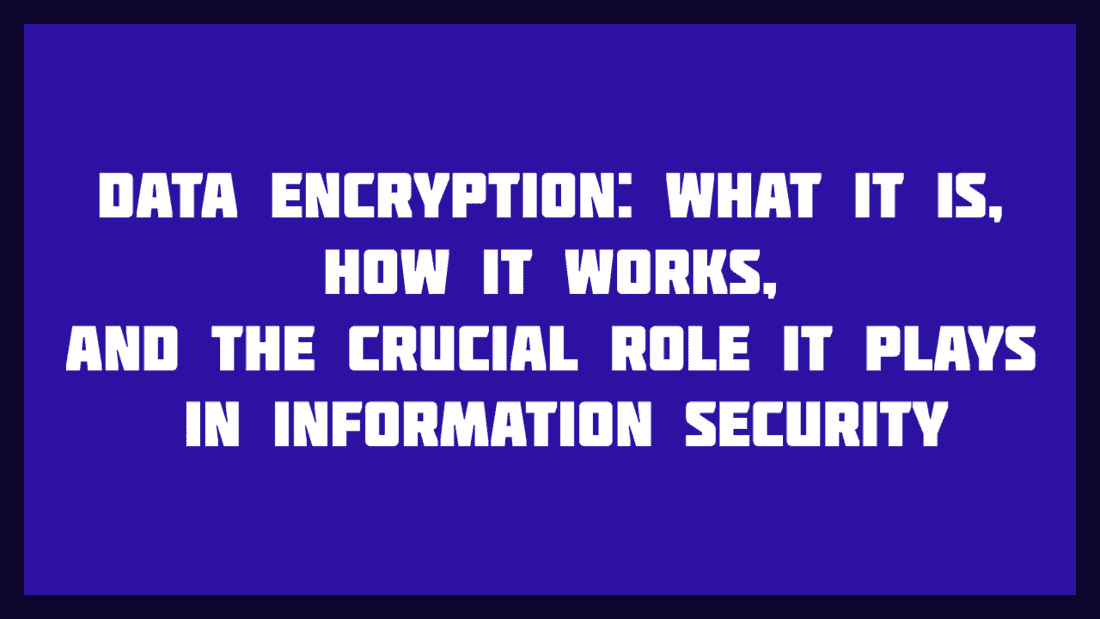Many advocate the merits and importance of data encryption but few truly understand how it works. Without cryptographic processes, consumer and business data would be constantly at risk. Understanding encryption helps keep systems safe.
By knowing what encryption is, how it works, and the crucial role it plays in information security, business leaders and average consumers alike can make better decisions for their data safety.
Here’s what you need to know.
What is Encryption?
Think of encryption as a lock and your keys are your passwords. This is the system that operates behind the scenes of many of our day-to-day processes, our mobile banking, and our digital storage.
Encryption is the process of securing information behind a cipher. It makes sensitive data unreadable to anyone without the necessary authorization. There are a wide variety of ways to encrypt data, but they all involve cryptographic functions that secure the plain text of data behind a code.
The security of this code depends on the complexity of the cryptographic key. The most powerful cryptographic encryptions make it all but impossible for would-be hackers to crack them.
The process of encryption is one of the most important protective measures for society as a whole. Not only does it keep private financial information safe from criminals, it serves as a check for government powers in the ability to seize and examine personal information. This helps guarantee democratic processes and protects our freedom and privacy.
But how does the average person go about understanding the complexity of cryptographic processes? And how can you make encryption work for you?
How Encryption Works?
Encryption doesn’t have to be as complicated as it may seem.
It all starts with an algorithm that converts the plain text data into something unreadable without the decryption key, which simply reverses that algorithm to re-translate the information back into plain text.
There are two primary ways encryption algorithms work: symmetric and asymmetric.
Symmetric encryption entails the use of a single key used for both encryption and decryption. The key converts a message into an unreadable state, then converts it back if applied by a user with the same key. This is a foundational method of ensuring data safety for all, and is common in the following processes:
- Mobile payments
- Multi-factor authentication
- Hash functions
Asymmetric encryption, on the other hand, uses two different keys. The encryption key is shared publicly, which is why this encryption method is also known as public key encryption. The other key, used for decryption, is kept private. This is the encryption technology that has made possible Transport Layer Security (TLS) and Secure Sockets Layer (SSL), both essential in maintaining internet security and privacy.
Asymmetric encryption methods are common in systems like:
- HTTPS internet security
- Email encryption
- Cryptocurrency transactions
The combination of both symmetric and asymmetric cryptography is also a feature of many highly secure systems, as it complicates encryption to best deter hackers. Decryption keys are mathematically linked and communicate when authorized parties apply the right processes.
But most people don’t need a highly complicated encryption system to protect their day-to-day data. Encrypting your passwords can be as simple as using strong passwords that are not easily guessed. However, a symmetrical authentication system is highly recommended.
Without these encryption methods, chaos would reign in the world of data.
The Role of Encryption in Information Security
It is estimated that there is 40 times more data stored than there are stars in the observable universe. Without the people and processes that keep this information safe, it would be a free-for-all for your most personal information. Luckily, however, we have information security analysts and database administrators acting constantly to retain the security of cryptographic functions.
These roles are vital in the ongoing efforts to secure data privacy, which is consistently under siege by both cybercriminals and governments across the world. Efforts have been made to force tech companies to insert backdoors into encrypted applications. This would allow law enforcement access without the necessary user decryption keys.
While law enforcement has the right to tap your phone under the right circumstances, backdoor and decryption remain more highly protected functions of our private information. Government actors need special permission and warrants to break into an encrypted system, providing a system of checks on our data freedoms and privacy.
Without encryption in information security, our data would be open to anyone with the knowledge and drive to access it. And who would want to live in such a world?
Bottom Line
Data encryption is the process of securing information behind a coded algorithm. This means only the authorized user with the decryption keys—in essence, your passwords—can access the secured data. Encryption, then, acts as a line of defense for our freedoms and privacy of information in the digital world.
While there are different types of encryption—some more secure than others—average users need only to follow best practices like using multi-factor authentication systems to retain high levels of security. As a result, the world of information security can function as it should, with our data kept private and safe.










Leave a Reply